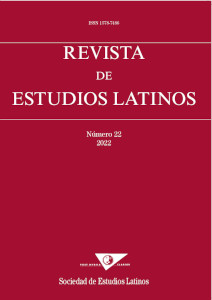Elegiac couplet and golden line
DOI:
https://doi.org/10.23808/rel.v22i0.96947Keywords:
golden line, hexameter, pentameter, Catullus, Tibullus, Propertius, OvidAbstract
This study aims to show how the verbal arrangement called the golden line has inevitably been adapted in the elegiac distich to the phonetic, verbal, syntactical and metrical organization of the unit constituted by the hexameter and the pentameter, with in particular, a transfer to the pentameter of what characterizes the hexameter, on the thematic and colometric level, when it is a golden line.
Downloads
References
Cairns, F. (1979) : Tibullus. A Hellenistic poet at Rome, Cambridge, Cambridge University Press.
Cairns, F. (2006) : Sextus Propertius, the Augustan Elegist, Cambridge, Cambridge University Press.
Ceccarelli, L. (2012) : « L’evoluzione del distico elegiaco fra Catullo e Ovidio », in Cristofoli R.-Santini C.-Santucci F. (éds), Properzio fra tradizione e innovazione. Atti del convegno internazionale (Assisi-Spello, 21-23 maggio 2010), Assisi, Accademia Properziana del Subasio, 47-97.
Ceccarelli, L., (2018) : Contributions to the History of the Latin Elegiac Distich, Turnhout, Brepols.
EnrÍquez López, S. (1988) : El hexámetro áureo en latín (datos para su estudio), thèse Université de Grenade, 1988.
Fedeli, P. (1980) : Il primo libro delle Elegie. Introd. testo crit. e comm. a cura di Fedeli P., Firenze, Olschki.
Fedeli, P. (1985) : Il libro terzio delle Elegie. Introd., testo et comm. di Fedeli P., Bari, Adriatica Ed.
Fordyce, C. J. (1961) : Catullus : a commentary, Oxford, Oxford University Press.
Foucher, A. (2016) : « La réécriture de Catulle dans l’Apocoloquintose de Sénèque (4,1) », Latomus 75, 3, 677-685.
Foucher, A. (2019) : « Les uersus aurei chez Virgile, des Bucoliques à l’Énéide », RPh 93, 1, 69-93.
Hellegouarc’h, J. (1998) : « Les yeux de la marquise… Quelques observations sur les commutations verbales dans l’hexamètre latin », in Dangel J. (éd.), Liberalitas. Scripta Varia rassemblés et présentés en hommage à J. Hellegouarc’h avec la participation de A. Foulon, Bruxelles, Latomus, Collection Latomus 243, 413-444 (première publication dans REL 65, 1987, 261-287).
Heyworth, S. J.-Morwood, J. H. W. (2011) : A Commentary on Propertius, book 3, Oxford, Oxford University Press.
Heyken, J. (1916) : Die Stellung der Epitheta bei den römischen Elegikern, Kiel, Druck von H. Fiencke.
Hoffer, S. (2007) : « The use of adjective interlacing (double hyperbaton) in Latin poetry », HSCPh 103, 299-340.
Hutchinson, G. O. (2006) : Propertius Elegies. Book IV, Cambridge-New York, Cambridge University Press.
Kenney, E. J. (1996) : Ovidius. Heroides. XVI-XXI, Cambridge-New-York, Cambridge University Press.
Knox, P. E. (1995) : Ovid Heroides. Selected epistles, Cambridge, Cambridge University Press.
Luque Moreno, J. (1994) : El dístico elegíaco. Lecciones de métrica latina, Madrid, Ediciones Clásicas.
Marina sáez, R. Mª. (1997) : «Algunos aspectos relativos a la disyunción del adjetivo y el nombre en el pentámetro griego y latino », Habis 28, 337-347.
Patzer, H. (1955) : « Zum Sprachstil des neoterischen Hexameters », MH 12, 77-95.
Rufener, R. (1935) : Die syntaktische Struktur der Distichen in der römischen Elegie, diss. Bern, Lenzburg, Christian Ebner Buchdruckerei.
Rasi, P. (1894) : De elegiae Latinae compositione et forma, Patauii, typis seminarii.
Saint-Denis, E. de (1936) : Le rôle de la mer dans la poésie latine, Paris, Klincksieck.
Wilkinson, L. P. (1963) : Golden Latin Artistry, Cambridge, Cambridge University Press.
Wohl, B. (1974) : «The phenomenon of Sperrung in Tibullus’ elegies », TAPhA 104, 385-428.
Downloads
Published
How to Cite
Issue
Section
License
Copyright (c) 2022 Revista de Estudios Latinos

This work is licensed under a Creative Commons Attribution-NonCommercial-NoDerivatives 4.0 International License.
The originals published in the printed and electronic editions of this journal are the property of the Revista de Estudios Latinos and can be circulated as long as the original source and authorship is made clear in any reproduction, full or partial, of the same, and as long as this is not done for commercial purposes.






